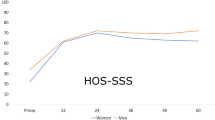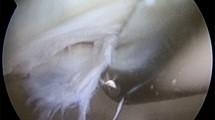Abstract
Purpose
To compare early outcomes of periacetabular osteotomy (PAO) with concomitant hip arthroscopy to isolated hip arthroscopy for femoroacetabular impingement (FAI) and chondrolabral pathology using patient-reported outcomes measurement information system (PROMIS).
Materials and methods
Consecutive patients scheduled for PAO with concomitant hip arthroscopy (PAO + HA) or isolated hip arthroscopy (HA) between the ages of 15 and 30 years old were prospectively included in the study. Based on power analysis, subjects were recruited until there were 22 subjects in the PAO + HA group. These subjects were then gender matched to the HA group. The PROMIS, with six subscales and two global health measures, were completed during preoperative and 6-month follow-up visits. One-way ANOVA was performed to compare intake information of age, symptom duration, body mass index, and Beighton scores as well as preoperative and 6-month postoperative PROMIS scores between the PAO + HA and HA.
Results
22 consecutive subjects undergoing PAO + HA were all females (average age 20.0 years) and matched to 22 consecutive females (average age 22.6) in the HA group. ANOVA did not find a significant difference between the two groups when comparing intact information, with exception of age (p = 0.04). A significant difference was also not identified (p ≥ 0.05) between the two groups on preoperative or 6-month postoperative PROMIS scores. The largest difference in 6-month postoperative scores between the two groups was 4.4 points on physical function subscale.
Conclusion
Outcomes at 6 months were not significantly different when comparing PAO + HA to HA for FAI and chondrolabral pathology in females under 30 years of age. The more extensive surgery with a prolonged protective period associated with PAO do not seem to negatively impact outcomes at 6 months when compared to HA. These finding support the use of PAO + HA, particularly if the patient and/or surgeon were concerned about prolonged disability, metal health issues, and/or higher pain levels that might be associated with the PAO procedure.


Similar content being viewed by others
References
Klaue K, Durnin CW, Ganz R (1991) Theacetabular rim syndrome. A clinical presentation of dysplasia of the hip. J Bone Joint Surg Br 73(3):423–429
Wyles CC, Vargas JS, Heidenreich MJ, Mara KC, Peters CL, Clohisy JC, Trousdale RT, Sierra RJ (2019) Natural history of the dysplastic hip following modern periacetabular osteotomy. J Bone Joint Surg Am 101(10):932–938. https://doi.org/10.2106/JBJS.18.00983
Clohisy JC, Schutz AL, St John L, Schoenecker PL, Wright RW (2009) Periacetabular osteotomy: a systematic literature review. ClinOrthopRelat Res 467(8):2041–2052. https://doi.org/10.1007/s11999-009-0842-6
Larsen JB, Mechlenburg I, Jakobsen SS, Thilleman TM, Soballe K (2020) 14-year hip survivorship after periacetabular osteotomy: a follow-up study on 1,385 hips. ActaOrthop 91(3):299–305. https://doi.org/10.1080/17453674.2020.1731159
Adler KL, Giordano BD (2019) The utility of hip arthroscopy in the setting of acetabular dysplasia: a systematic review. Arthroscopy 35(1):237–248. https://doi.org/10.1016/j.arthro.2018.07.048
Matheney T, Kim YJ, Zurakowski D, Matero C, Millis M (2009) Intermediate to long-term results following the Bernese periacetabular osteotomy and predictors of clinical outcome. J Bone Joint Surg Am 91(9):2113–2123. https://doi.org/10.2106/JBJS.G.00143
Siebenrock KA, Scholl E, Lottenbach M, Ganz R (1999) Bernese periacetabular osteotomy. ClinOrthopRelat Res 363:9–20
Ginnetti JG, Pelt CE, Erickson JA, Van Dine C, Peters CL (2013) Prevalence and treatment of intraarticular pathology recognized at the time of periacetabular osteotomy for the dysplastic hip. ClinOrthopRelat Res 471(2):498–503. https://doi.org/10.1007/s11999-012-2602-2
Jones DM, Crossley KM, Ackerman IN, Hart HF, Dundules KL, O’Brien MJ, Mentiplay BF, Heerey JJ, Kemp JL (2020) Physical activity following hip arthroscopy in young and middle-aged adults: a systematic review. Sports Med Open 6(1):7. https://doi.org/10.1186/s40798-020-0234-8
Kierkegaard S, Langeskov-Christensen M, Lund B, Naal FD, Mechlenburg I, Dalgas U, Casartelli NC (2017) Pain, activities of daily living and sport function at different time points after hip arthroscopy in patients with femoroacetabular impingement: a systematic review with meta-analysis. Br J Sports Med 51(7):572–579. https://doi.org/10.1136/bjsports-2016-096618
Flores SE, Sheridan JR, Borak KR, Zhang AL (2018) When do patients improve after hip arthroscopy for femoroacetabular impingement? A prospective cohort analysis. Am J Sports Med 46(13):3111–3118. https://doi.org/10.1177/0363546518795696
Wolfson TS, Ryan MK, Begly JP, Youm T (2019) Outcome trends after hip arthroscopy for femoroacetabular impingement: when do patients improve? Arthroscopy 35(12):261–3270. https://doi.org/10.1016/j.arthro.2019.06.020
Domb BG, LaReau JM, Hammarstedt JE, Gupta A, Stake CE, Redmond JM (2015) Concomitant hip arthroscopy and periacetabular osteotomy. Arthroscopy 31(11):2199–2206. https://doi.org/10.1016/j.arthro.2015.06.002
Gosey GM, Muldoon MP, Healey RM, Santore RF (2018) Operative findings and complications associated with adjunctive hip arthroscopy in 95 hips undergoing periacetabular osteotomy. Hip Int 28(3):278–283. https://doi.org/10.5301/hipint.5000564
Redmond JM, Gupta A, Stake CE, Domb BG (2014) The prevalence of hip labral and chondral lesions identified by method of detection during periacetabular osteotomy: arthroscopy versus arthrotomy. Arthroscopy 30(3):382–388. https://doi.org/10.1016/j.arthro.2013.11.013
Leunig M, Siebenrock KA, Ganz R (2001) Rationale of periacetabular osteotomy and background work. Instr Course Lect 50:229–238
Millis MB, McClincy M (2018) Periacetabular osteotomy to treat residual dysplasia in adolescents and young adults: indications, complications, results. J Child Orthop 12(4):349–357. https://doi.org/10.1302/1863-2548.12.180068
Sabbag CM, Nepple JJ, Pascual-Garrido C, Lalchandani GR, Clohisy JC, Sierra RJ (2019) The addition of hip arthroscopy to periacetabular osteotomy does not increase complication rates: a prospective case series. Am J Sports Med 47(3):543–551. https://doi.org/10.1177/0363546518820528
Kim KI, Cho YJ, Ramteke AA, Yoo MC (2011) Peri-acetabular rotational osteotomy with concomitant hip arthroscopy for treatment of hip dysplasia. J Bone Joint Surg Br 93(6):732–737. https://doi.org/10.1302/0301-620X.93B6.25809
Maldonado DR, LaReau JM, Perets I, Ortiz-Declet V, Laseter JR, Lall AC, Domb BG (2019) Outcomes of hip arthroscopy with concomitant periacetabular osteotomy, minimum 5-year follow-up. Arthroscopy 35(3):826–834. https://doi.org/10.1016/j.arthro.2018.10.143
Ricciardi BF, Mayer SW, Fields KG, Wentzel C, Kelly BT, Sink EL (2016) Patient characteristics and early functional outcomes of combined arthroscopic labralrefixation and periacetabular osteotomy for symptomatic acetabular dysplasia. Am J Sports Med 44(10):2518–2525. https://doi.org/10.1177/0363546516651829
Thanacharoenpanich S, Boyle MJ, Murphy RF, Miller PE, Millis MB, Kim YJ, Yen YM (2018) Periacetabular osteotomy for developmental hip dysplasia with labral tears: is arthrotomy or arthroscopy required? J Hip PreservSurg 5(1):23–33. https://doi.org/10.1093/jhps/hnx048
Rothrock NE, Amtmann D, Cook KF (2020) Development and validation of an interpretive guide for PROMIS scores. J Patient Rep Outcomes 4(1):16. https://doi.org/10.1186/s41687-020-0181-7
Hahn EA, Devellis RF, Bode RK, Garcia SF, Castel LD, Eisen SV, Bosworth HB, Heinemann AW, Rothrock N, Cella D, Group PC (2010) Measuring social health in the patient-reported outcomes measurement information system (PROMIS): item bank development and testing. Qual Life Res 19(7):1035–1044. https://doi.org/10.1007/s11136-010-9654-0
Kollmorgen RC, Hutyra CA, Green C, Lewis B, Olson SA, Mather RC 3rd (2019) relationship between PROMIS computer adaptive tests and legacy hip measures among patients presenting to a tertiary care hip preservation center. Am J Sports Med 47(4):876–884. https://doi.org/10.1177/0363546518825252
Nwachukwu BU, Beck EC, Chapman R, Chahla J, Okoroha K, Nho SJ (2019) Preoperative performance of the PROMIS in patients undergoing hip arthroscopic surgery for femoroacetabular impingement syndrome. Orthop J Sports Med 7(7):2325967119860079. https://doi.org/10.1177/2325967119860079
Li DJ, Clohisy JC, Schwabe MT, Yanik EL, Pascual-Garrido C (2020) PROMIS versus legacy patient-reported outcome measures in patients undergoing surgical treatment for symptomatic acetabular dysplasia. Am J Sports Med 48(2):385–394. https://doi.org/10.1177/0363546519894323
Wyatt MC, Beck M (2018) The management of the painful borderline dysplastic hip. J Hip PreservSurg 5(2):105–112. https://doi.org/10.1093/jhps/hny012
Dangin A, Tardy N, Wettstein M, May O, Bonin N (2016) Microinstability of the hip: a review. OrthopTraumatolSurg Res 102(8S):S301–S309. https://doi.org/10.1016/j.otsr.2016.09.002
Ricciardi BF, Fields KG, Wentzel C, Kelly BT, Sink EL (2017) Early Functional outcomes of periacetabular osteotomy after failed hip arthroscopic surgery for symptomatic acetabular dysplasia. Am J Sports Med 45(11):2460–2467. https://doi.org/10.1177/0363546517710011
Pascual-Garrido C, Harris MD, Clohisy JC (2017) Innovations in joint preservation procedures for the dysplastic hip “the periacetabular osteotomy.” J Arthroplasty 32(9S):S32–S37. https://doi.org/10.1016/j.arth.2017.02.015
Kamath AF (2016) Bernese periacetabular osteotomy for hip dysplasia: surgical technique and indications. World J Orthop 7(5):280–286. https://doi.org/10.5312/wjo.v7.i5.280
Peters CL, Erickson JA, Anderson MB, Anderson LA (2015) Preservation of the rectus femoris origin during periacetabular osteotomy does not compromise acetabular reorientation. ClinOrthopRelat Res 473(2):608–614. https://doi.org/10.1007/s11999-014-3837-x
Goronzy J, Franken L, Hartmann A, Thielemann F, Postler A, Paulus T, Gunther KP (2017) What are the results of surgical treatment of hip dysplasia with concomitant cam deformity? ClinOrthopRelat Res 475(4):1128–1137. https://doi.org/10.1007/s11999-016-5054-2
Author information
Authors and Affiliations
Contributions
All authors contributed to the study conception and design. Material preparation, data collection and analysis were performed by TE, DK, BR, KE, AP, and RM. The first draft of the manuscript was written by RM and all authors commented on previous versions of the manuscript. All authors read and approved the final manuscript.
Corresponding author
Ethics declarations
Ethics approval
All procedures performed involving human subjects were in accordance with the Ethical Standards of the Institutional Research Committee and with the 1964 Helsinki Declaration and its later amendments.
Consent to participate and publication
Informed consent for participation and publication was obtained from all individual participants or legal guardian.
Additional information
Publisher's Note
Springer Nature remains neutral with regard to jurisdictional claims in published maps and institutional affiliations.
Rights and permissions
About this article
Cite this article
Ellis, T., Kohlrieser, D., Rao, B. et al. A comparison of 6-month outcomes between periacetabular osteotomy with concomitant hip arthroscopy to isolated hip arthroscopy for femoroacetabular impingement. Arch Orthop Trauma Surg 142, 471–480 (2022). https://doi.org/10.1007/s00402-021-03886-0
Received:
Accepted:
Published:
Issue Date:
DOI: https://doi.org/10.1007/s00402-021-03886-0




